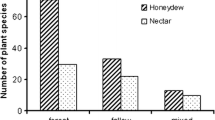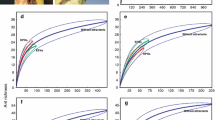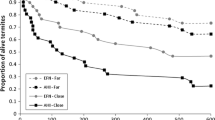Abstract.
Ant-plant interactions in the canopy of a lowland Amazonian rainforest of the upper Orinoco, Venezuela, were studied using a modified commercial crane on rails (Surumoni project). Our observations show a strong correlation between plant sap exudates and both abundance of ants and co-occurrence of ant species in tree canopies. Two types of plant sap sources were compared: extrafloral nectaries (EFNs) and honeydew secretions by homopterans. EFNs were a frequent food source for ants on epiphytes (Philodendron spp., Araceae) and lianas (Dioclea, Fabaceae), but rare on canopy trees in the study area, whereas the majority of trees were host to aggregations of homopterans tended by honeydew-seeking ants (on 62% of the trees examined). These aggregations rarely occurred on epiphytes. Baited ant traps were installed on plants with EFNs and in the crowns of trees from three common genera, including trees with and without ant-tended homopterans: Goupia glabra (Celastraceae), Vochysia spp. (Vochysiaceae), and Xylopia spp. (Annonaceae). The number of ant workers per trap was significantly higher on plants offering one of the two plant sap sources than on trees without such resources. Extrafloral nectaries were used by a much broader spectrum of ant species and genera than honeydew, and co-occurrence of ant species (in traps) was significantly higher on plants bearing EFNs than on trees. Homopteran honeydew (Coccidae and Membracidae), on the other hand, was mostly monopolised by a single ant colony per tree. Homopteran-tending ants were generally among the most dominant ants in the canopy. The most prominent genera were Azteca, Dolichoderus (both Dolichoderinae), Cephalotes, Pheidole, Crematogaster (all Myrmicinae), and Ectatomma (Ponerinae). Potential preferences were recorded between ant and homopteran species, and also between ant-homopteran associations and tree genera. We hypothesize that the high availability of homopteran honeydew provides a key resource for ant mosaics, where dominant ant colonies and species maintain mutually exclusive territories on trees. In turn, we propose that for nourishment of numerous ants of lower competitive capacity, Philodendron and other sources of EFNs might be particularly important.
Similar content being viewed by others
Author information
Authors and Affiliations
Additional information
Electronic Publication
Rights and permissions
About this article
Cite this article
Blüthgen, N., Verhaagh, M., Goitía, W. et al. How plants shape the ant community in the Amazonian rainforest canopy: the key role of extrafloral nectaries and homopteran honeydew. Oecologia 125, 229–240 (2000). https://doi.org/10.1007/s004420000449
Received:
Accepted:
Published:
Issue Date:
DOI: https://doi.org/10.1007/s004420000449




